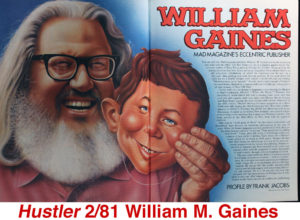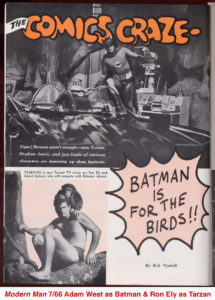This article I Only Read It For The Articles was written in 2004 for the fanzine the The Comic Book Marketplace . The editor Gary Carter said he would publish it. However Gary resigned soon afterwards and the new editor, Russ Cochran, had no interest in it. I next tried to submit it to Roy Thomas the editor of the fanzine Alter-Ego but he also had no interest. But now in 2022 I’ve dusted it off and put it on my The Leader’s Chronicles website just in case somebody, somewhere besides me might have some interest in it.
I Only Read It For The Articles
Many Silver Age comic book collectors enjoy reading articles about old comic books in the specialty magazines devoted to the subject. I also think its fun to read about old comic books and their creators in other magazines to see what the rest of the world thinks about our hobby. Granted, many such articles are frivolous and misinformed but not all of them are. All of the articles I’ve reviewed here have obscure facts or rare artwork not always available in the regular comic book hobby magazines. Articles about old comic books are scattered all over many different types of magazines and I can’t cover them all. With the exception of Saga and Esquire all of the magazines reviewed below are from a specific genre. They are adult magazines, or in the trade jargon, “girlie” magazines. I picked this genre for a reason that any comic book collector over age 40 would appreciate. Like comic books used to be, girlie magazines today are a subculture outside of mainstream society and are held in contempt and disfavor by much of that society. You may have to hide them from your wife or girlfriend the same way you hid your comics from your parents or school teachers when you were a kid. The articles and interviews reviewed below give enough brief information to help you decide if you want to locate the magazine to read the entire piece. In this Internet age finding old magazines isn’t as hard as it used to be. A few mouse clicks on eBay could have many of these magazines on your doorstep in a few days.
Biographies Of Comic Book Creators
Frank Frazetta
Esquire June 1977
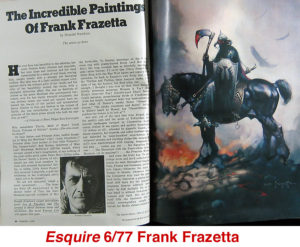 “The Incredible Paintings of Frank Frazetta” by Donald Newlove. Eleven pages with several Frazetta paintings and sketches.
“The Incredible Paintings of Frank Frazetta” by Donald Newlove. Eleven pages with several Frazetta paintings and sketches.
Frank Frazetta isn’t the greatest comic book artist in the world. He is however the greatest artist in the world who ever worked in comic books. This is the longest article about Frazetta to appear in a magazine not related to comic books.
The author admires Frazetta. He points out that Frazetta has no intellectual pretensions and that his earthy, forceful art style is out of sync with the intellectual critics who get to define what Fine Art is in America. Ironically, the author writes his article in a gaseous literary style that would appeal to the same snobs who snub Frazetta.
Frazetta’s early life and work in comics is briefly touched on. More information is presented about his paperback book covers for Ace and Lancer that finally brought him into the public eye.
Most of the article reports on the author’s visit to Frazetta at his home in East Stroudsberg, Pennsylvania. The premise of the young fan getting to the Great Master is always interesting and the author does nicely convey his dumbstruck awe at seeing the many original oil paintings scattered about the Frazetta home. The author’s discussions with Frazetta about some of his most famous works – Egyptian Princess, Sea Witch, Silver Warrior, Cat Girl – are interesting with this caveat; the author is fascinated with the sensual element in Frazetta’s work and his descriptions of this get out of hand. He goes into a lengthy digression on the libidinous quality of Cat Girl and its affect on him that is ridiculous.
We do learn a few lesser known tidbits about Frazetta’s personal life. He collects cameras and guns. He doesn’t read much but has a preference for Robert E. Howard over Edgar Rice Burroughs. He doesn’t answer much fan mail and is puzzled by the letters he gets from professorial types who over-analyze his work. We are also reminded of the first two things everybody learns about Frazetta: he retains ownership of all his originals and only paints when he’s not doing something really important, like playing baseball.
Lastly, Frazetta talks about his artistic style and I imagine aspiring art students will want to read this. Please do, but don’t take it to much to heart. Develop you own style instead. We have enough Frazetta imitators already and no one is going to beat him on his own turf.
William Gaines
Oui February 1979
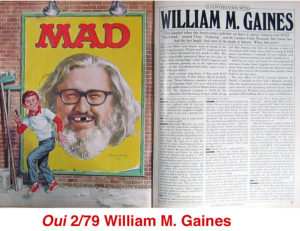 “A Conversation With William Gaines” interview by Jeff Goldberg. Eight pages including full page color painting of Gaines and Alfred E. Neuman, Mad color cover reprints and art by Don Martin.
“A Conversation With William Gaines” interview by Jeff Goldberg. Eight pages including full page color painting of Gaines and Alfred E. Neuman, Mad color cover reprints and art by Don Martin.
To comic book fans, William M. Gaines is well known as the legendary publisher of EC comics and Mad magazine. To the general public of course he’s almost completely unknown. I say almost because the enduring popularity of Mad magazine has put Gaines on the margins of that tiny group of magazine publishers like Malcom Forbes, Henry Luce, Hugh Hefner and precious few others whose names are recognized outside of the publishing industry. Unlike his fellow publishing legends, Gaines never published a magazine devoted to popular subjects like money and sex so what recognition he does have seems all the more well deserved.
In the interview Gaines talks about his father inventing the American comic book but then passing on the opportunity to publish Superman. He mentions taking over the EC comics line when his father was killed and talks briefly about his own publishing years at EC and his appearance before the Senate committee investigating juvenile delinquency. He notes the “severed head” interrogation there that didn’t make him anymore popular with the Senators. He goes on to discuss the origin of Mad with Harvey Kurtzman, practical jokes around the office, Mad’s aversion to sick humor, its lack of a political viewpoint and competition from National Lampoon.
To me, the most interesting parts of the interview are Gaines’s recollections of being sued by Ava Gardner and Irving Berlin, receiving a possible letter from Prince Charles complaining about being compared to Alfred E. Neuman and receiving polite visits from the Secret Service and FBI, all from features that ran in Mad.
Gaines touches on his personal life as well: his favorite comic strip is Doonesbury, doesn’t read to many magazines except those about food and wine, doesn’t partake of illegal drugs, admits to having a hot temper and doesn’t believe in UFOs anymore. Gaines talks extensively about the copyright lawsuit over the Alfred E. Neuman image and notes Alfred’s image had been around since 1890 with a copyright as early as 1914. Although Mad’s reputation rests on needling the Establishment, Gaines himself comes across as a mellow, affable old guy with endless funny stories to tell. I wish I could have met him.
“William Gaines Mad Magazines Eccentric Publisher” article by Frank Jacobs. Six pages including a nearly two page color painting of Gaines and Alfred E. Neuman and a few color reprints of EC horror comic book covers and interiors.
Mad insider Frank Jacobs wrote the only Gaines biography, The Mad World of William M. Gaines. I’ve never been able to find this long out of print book so I don’t know if this article contains information not in the book.
Jacobs describes Gaines’s early life and notes his concern over inheriting his father’s comic book company with this quote: “How the hell can I run a business when I couldn’t even make it as the old man’s stockroom boy?”
Briefly mentioned are the EC comic days, the Senate hearings and the origin of Mad magazine.
Jacobs goes into detail on the origin of the Alfred E. Neuman character as Mad’s mascot and the resulting copyright lawsuit that could have destroyed Gaines’s publishing company if he had lost it.
I think the best parts of the article describe Gaines’s personal habits: staying off of everybody’s best dressed list, never cleaning his apartment, getting into 30 automobile accidents, keeping a wine vault in his living room and numbering the pants in his closet to correspond to his current weight. Fair enough. We can’t expect the publisher of Mad to be a fashion model for GQ magazine.
Jack Kirby
Esquire May 1967
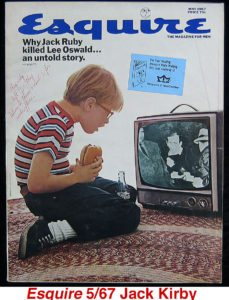 “46 Hours and 36 Minutes In The Life of Jack Ruby” three page illustrated comic strip story by Jack Kirby in color.
“46 Hours and 36 Minutes In The Life of Jack Ruby” three page illustrated comic strip story by Jack Kirby in color.
This Kirby item is unique. It is the only complete Kirby story to appear in a major American magazine. The story is a supplement to a regular article about Jack Ruby killing Lee Harvey Oswald. The story’s title appears in a colored block on the article’s first page. There is no splash page with artist or writer credits but Kirby is credited on the magazine’s table of contents page.
The story relates the Warren Report’s version of Jack Ruby’s actions up to the second he shot Oswald. The story’s dialog and plot has a choppy, chaotic feel that Kirby’s writing was noted for so he may have written it himself. There are 37 numbered footnotes in the story’s captions and dialog balloons that reference the appropriate volume in the Warren Report. I’m sure Kirby didn’t study all 26 volumes of the Report or even the one volume condensed version to execute this assignment. The article’s editor probably gave Kirby an outline to use, but who knows? If anybody knows the facts behind this esoteric piece of Kirbyana please write in to this magazine and tell us.
This issue of Esquire is a double-whammy collectible. The Jack Ruby article is featured on the cover and would appeal to Kennedy Assassination fans and the Jack Kirby story is unknown to many of Kirby’s legion of fans. You can probably steal it off eBay for under 10 dollars. I’ve included an image of the magazine cover at right to help you do that.
Harvey Kurtzman
Playboy December 1957
“The Little World Of Harvey Kurtzman” by Rolf Malcolm. Three text pages and nine pages of color artwork and photographs.
Important, large circulation magazines in the 1950s rarely featured articles on cartoonists. If they did bother to at all, it was only for a really big name like Milton Caniff or Al Capp. One important magazine however in the 1950s was owned by a former cartoonist, Hugh Hefner. So, as early as 1957 Playboy published this article on Harvey Kurtzman, who wasn’t exactly a household name.
Kurtzman fans should enjoy this article which is well written and gives a basically accurate summary of Kurtzman’s career. Much of the article describes examples of Kurtzman’s maniacally meticulous work on the EC title Two Fisted Tales which drove all the artists working for him crazy.
Kurtzman’s involvement with Mad is extensively covered of course although the author does seem to mistakenly assume that Kurtzman created Mad entirely by himself with no help from EC publisher William Gaines. The author is correct about the transformation of Mad from a comic book into a magazine; Kurtzman was offered a plush job at Pageant magazine and Gaines agreed to turn Mad into magazine to placate Kurtzman and keep him at EC.
Articles about Mad in mainstream magazines frequently note the negative reviews it received from Time and others on its debut. I was surprised to learn that the Mad comic book received favorable reviews from some high-brow magazines like Commentary and England’s Journal of Education , both of of which are quoted from.
Also covered in detail is Kurtzman’s creation of Trump after he left Mad. Trump was a lush, full color magazine on slick paper financed by Playboy’s publisher. The color printing was so expensive even Playboy couldn’t afford it and Trump folded after two issues. Some of the unused material was used in Kurtzman’s next short lived title, Humbug.
This article reprints color pages of Kurtzman supervised material from Trump with art by Wally Wood, Jack Davis, Will Elder and Al Jaffee. Trump is a difficult magazine to find and this easily available issue of Playboy may serve Kurtzman collectors as a temporary substitute for the more elusive Trump.
Esquire June 1971
“@ $ # !! or Takin’ The Lid Off The Id” by Harvey Kurtzman. Eight color pages of reprints from newspaper comic strips, Tijuana Bibles, comic books and underground comic books.
This is the only feature I’ve included that deals more with comic strips rather than comic books. I’ve included it because it was written by a famous comic book artist and writer and includes some reprints of comic book art.
There isn’t much text here. Kurtzman provides a short introduction and brief captions to the reprints of the items listed above. Kurtzman traces the history of the American comic strip and related spin-offs like comic books. He talks about how the comics reflected the changes in American society from the 1890s to present. Some of the comic strip reprints with his comments are Flash Gordon, Terry And The Pirates, Popeye, and Prince Valiant. There is one page of comic book reprints with art from EC, Fiction House and DC. There is one page of reprints from underground comics.
Stan Lee
Cavalier July 1972
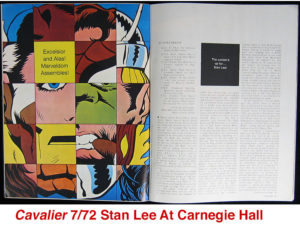 “Excelsior and Alas! Marveldom Assembles” article by Ed McCormack. Four pages including full page color illustration of Stan Lee’s face as a composite of Marvel characters.
“Excelsior and Alas! Marveldom Assembles” article by Ed McCormack. Four pages including full page color illustration of Stan Lee’s face as a composite of Marvel characters.
Most of this article reviews the appearance of Stan Lee and the Marvel bullpen at Carnegie Hall in New York City. I recollect reading about this event in the Marvel comics 28 years ago which of course described it as a smash hit. This review doesn’t claim it was a flop but it isn’t very friendly either.
Lee is described as wearing a turtleneck sweater that looks like a Baggy. The bullpen is described as “a group of shy, self-effacing non-performers who mutely walked out on stage…” to never-the-less thunderous applause. Journalist Tom Wolfe’s and Stan Lee’s reading of passages from Marvel comics are given lukewarm evaluation and the article even notes that several of the slides in the slide show were upside down or backward. The article concedes that most of the audience of Marvel fans were happy just to see Lee and the bullpen in person. But, it also claims many of the fans were bored and some even took to fashioning their Marvel comics into paper airplanes.
I wasn’t there but I suspect this review is unduly harsh and that most fans think they got their money’s worth. If a reader out there who was there please write in and let us know what the mood of the audience really was and if Mr. Lee’s sweater really looked all that sloppy.
A large part of this article examines Stan Lee’s status as a “middle aged” popular culture guru similar to Timothy Leary or Marshall McLuhan. Lee is described as famous enough to receive praise from other pop culture icons like Frank Zappa, John Lennon and Federico Fellini.
Unless you have a special interest in the topics covered you should pass on reading this article. It is written in a self consciously important and convoluted style that quickly irritates. Ironically, it is similar to the Stan’s Soapbox editorials that use 40 words to make a point when 10 would have sufficed.
Oui March 1977
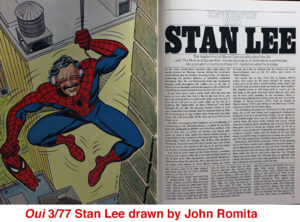 “Conversation With Stan Lee” interview by Anne Beatts. Seven pages including a full page color illustration of Lee as Spider-Man by John Romita.
“Conversation With Stan Lee” interview by Anne Beatts. Seven pages including a full page color illustration of Lee as Spider-Man by John Romita.
Most of this interview concern’s Stan Lee’s 35 year association with Marvel Comics naturally enough. The information presented was reasonably fresh in 1977 but has been repeated in several interviews with Lee since, so I want repeat it here.
I would like to list some items Lee discusses that may not be as commonly known. Lee admits he always wanted to be an actor more than a writer; he hates the mechanics of writing but loves the end result; during his Army years in World War II he drew a VD poster that was widely distributed; he deliberately violated the Comics Code to do an anti-drug series of stories in The Amazing Spider-Man and was dismayed when DC Comics copied Marvel’s lead with the more blatant approach of showing a man sticking a needle in his arm on the cover of a comic book; he wrote for the Howdy Doody comic strip as well as others and did ghost writing for TV and radio; he received visits in his office from famous film directors Federico Fellini and Alan Resnais; Marvel briefly published an underground comic book with art by Dennis Kitchen. There is no denying Mr. Lee possesses considerable wit and charm and it shows through in this interview. If you’re not burned out on reading all the other interviews he’s given in the last 23 years please try this one.
Genesis February 1979
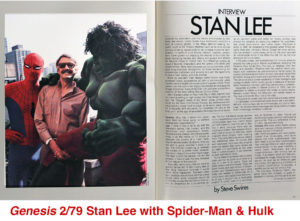 “Stan Lee” interview by Steve Swires. Five pages including a full page color photograph of Stan Lee with Spider-Man and the Hulk.
“Stan Lee” interview by Steve Swires. Five pages including a full page color photograph of Stan Lee with Spider-Man and the Hulk.
None of the questions in this interview pertain to Stan Lee’s years at Marvel Comics as a writer or editor. Almost all of the questions relate to Lee’s supervision of Marvel’s expansion into TV and films. The interviewer’s comments are quite pointed. He suggests the Spider-Man and Hulk TV programs “misrepresent” the characters, that Marvel has little control over the treatment of its properties on TV, and even that Marvel is dealing with TV people who are “…the least talented in Hollywood.”
Lee diplomatically disagrees with this last assertion but admits the shows aren’t presented the way he would like and says that Marvel intends to exercise more control over the TV and movie versions of its characters in the the future. Lee candidly confesses that he’s not as impressed with TV people as he was before and that Marvel should be able to produce television programming of superior quality. He says he’s frustrated by the Hollywood attitude that comic book characters can only be done as routine adventure shows like The Six-Million Dollar Man or as “camp” like the current Wonder Woman or the 1960s Batman.
The interviewer next brings up two more unpleasant topics for Lee’s response – the failure of the Howard the Duck syndicated newspaper strip by Steve Gerber and the comic book industry’s refusal to pay comic artists and writers a percentage of the profits on the comic books they create. Lee explains why he thinks Howard flopped and offers a publisher’s viewpoint on the lack of employee profit sharing that in some ways seems quiet reasonable.
Lee finishes with this quote: “I want us to be the next Warner Brothers. We’ve got the product and the know-how…we just have to figure out how to translate all of that into…[making] our own films and television shows.” Sadly, Mr. Lee never figured it out. In his 28 year career as a Hollywood mogul, not a single live action movie or TV series was produced that any Marvel fan could be proud of. Apparently, the modern day blockbuster Spider-Man, X-Men and Hulk movies that we are proud of are partly the result of Mr. Lee not having as much power as he once did in Marvel’s corporate hierarchy. Fortunately before Hollywood, Mr. Lee had a more substantial 31 year career as as comic book writer. The last 11 years of that career from 1961 to about 1971 were absolutely fabulous and all of us old time Marvel fans will always have that to cherish.
History, Nostalgia, Collecting
Playboy October 1965
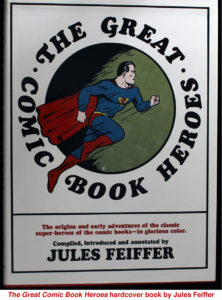 “The Great Comic Book Heroes” by Jules Feiffer. Nine pages with color Golden Age reprints on every page.
“The Great Comic Book Heroes” by Jules Feiffer. Nine pages with color Golden Age reprints on every page.
This article is my candidate for the first lengthy treatment of comic books as an art form to appear in a large circulation magazine. All articles before 1965 that took comic books seriously were brief and appeared in obscure, academic type magazines like The New Republic that not many people read. Popular magazines like The Ladies Home Journal in the 1950s had articles on comic books but only as something to be burned or censored.
The author, famous writer and cartoonist Jules Feiffer, worked in the comic book industry in the 1940s, mostly for Will Eisner. Feiffer says he could sign Eisner’s name better than Eisner himself. Feiffer’s article is not straight history but a nostalgic look at comic books mostly before 1945. He offers his impressions of Superman, Batman, Captain Marvel, Wonder Woman, Sheena Queen of the Jungle, Captain American and the Spirit.
Two highlights of his commentary are the sexual triangle between Superman/Clark Kent and Lois Lane and his comparison of the many similarities between Batman and the Green Hornet.
Feiffer writes extensively about his hero, Will Eisner. He covers Eisner’s work at Fiction House and Quality and of course has lots to say about Eisner’s most famous creation, the Spirit. Feiffer talks about DC artists routinely swiping the Terry and the Pirates, Flash Gordon and Prince Valiant newspaper comic strips. He defends the practice and admits to keeping a large Eisner swipe file, along with every other cartoonist in the business.
Lastly, Feiffer discusses the impact of World War II on comics with reference to Simon and Kirby and mentions Dr. Wertham’s 1950s assault on comics.
This article is condensed from the hardcover book published in 1965. The article appeared before the book which gives the article some status as a collectible. Here are three Feiffer quotes to entice you into reading the article. On where to find other superheroes to copy Superman: “Not on other planets; Superman had all the other planets tied up legally.” On Wonder Woman: “Why was she so flat chested?” On Robin the Boy Wonder: “…how I hated him. You can imagine how pleased I was when, years later, I found out he was a fag.”
“Batman Is For The Birds” by Bob Nystedt. Six pages with photos of the Batman TV show, the Superman Broadway play, Bob Kane, Ron Ely as Tarzan and examples of the Batmania sweeping the country.
This article appeared before the second season of the Adam West Batman TV series. It is mildly contemptuous of the Batmania craze caused by that show but does a better job of examining it than the many more frivolous magazine articles of that day.
Background information on Batman’s creator, Bob Kane, is provided along with a quote from Kane on why he thinks comic book characters are important. The show’s producer, Bob Dozier, and its stars Adam West and Burt Ward are briefly profiled and all three are asked about Dr. Wertham’s claim that Batman and Robin are homosexuals. Adam West had the best reply: “Just add them [homosexuals] to the Nielsen ratings.” A large portion of the article covers Dozier’s plans for two other shows based on comic book characters, the Green Hornet who made it in on the air and Wonder Woman who didn’t.
Extensively covered is the NBC network’s plans for a TV show to compete with Batman in the 1966 season – Tarzan starring Ron Ely. This revised version of Tarzan eliminated Jane which worried the NBC brass. They thought it might lead to speculation that Tarzan was having sex with apes. The problem was researched and the article quotes from an internal NBC memo that reported there was no evidence of Tarzan doing that in the “716 Tarzan stories” studied. Also, the memo reassured everyone that Tarzan’s dating habits “were considered normal for the upper Congo.”
Saga Oct 1966
“Capt. Marvel Vs. Superman” by Sam Henderson. 4 pages with routine black and white graphics of comic book sound effects.
This article was written in response to the publicity caused by the Batman TV show of the time. By today’s standards the author’s knowledge of comic books appears superficial but that was normal for 1966. Aside from a tiny number of researchers like Jerry Bails, nobody back then considered comic books worthy of serious study anyway.
The author recreates the origins of Superman, Batman and Capt. Marvel with enough purple prose to satisfy a Batman TV scriptwriter but he gets the facts essentially correct. I had forgotten myself that Superman was adopted from an orphanage by the Kents and not found by them originally. The author also recreates the first meeting between Jerry Siegel and Joe Shuster with DC publisher Harry Donnenfeld where he gently relieved them of all rights to Superman. Direct quotations are used which are inappropriate as I’m sure Donnenfeld didn’t have a tape recorder running during the meeting.
Much of the article focuses on the two most famous lawsuits in comic book publishing history – Siegel and Shuster’s suit against Superman’s publisher and that same publisher’s suit against Fawcett Publications for using Capt. Marvel to infringe on Superman’s copyrights. Several interesting details about these cases are presented but I’m not an expert and can’t verify them. If you’re interested in this litigious niche of comic book history this article is worth your time.
Esquire May 1972
“In The Absence Of A Hero For The 1970s” one page of text with color comic book cover and splash page reprints. Also, six pages of color comic strips.
This is one of those odd-ball comic related features Esquire runs sometimes. The brief introduction claims that heroism is extinct in modern society except in comic books. To help remedy this, Esquire commissioned six young comic book artists to “create a new generation of heroes…for the Seventies.” The six chosen were Berni Wrightson, Jeff Jones, Mike Ploog (copying Will Eisner), Barry Smith, Ralph Reese, and Alan Weiss and each submits here a one page comic strip.
Gallery February 1973
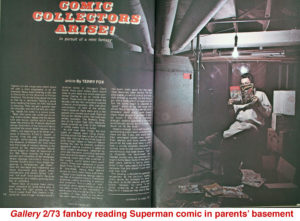 “Comic Collector’s Arise” by Terry Fox. Four pages including a full page color photo of a “fan-boy” reading a comic book.
“Comic Collector’s Arise” by Terry Fox. Four pages including a full page color photo of a “fan-boy” reading a comic book.
This article has the same accuracy and insider knowledge found in the Mike Baron article for Oui reviewed below. Unlike the Baron article comic book collectors aren’t skewered for their lack of social grace, but the same point is made by the color photo accompanying the article; the collector reading his Superman comic is a bit pudgy, wears glasses and is sitting in an attic or basement. Everybody in the real world knows Star Trek and comic book fans live in their parents’ basements, right? Allow me to make a personal observation. Sotheby’s auctions, art gallery shows and professional grading services will never signal the full acceptance of comic books into mainstream American life. That day will only come when a magazine like Time or Forbes publishes a photograph that shows a man who looks like a young Troy Donahue reading a comic book with a young Annette Funicello type female looking for his shoulder. Comic book collecting has never been and should never be entirely respectable. If you want to be respectable, collect stamps or coins. End of personal opinion.
This article was written when the most expensive comic books on the planet costs less than $400.0 and this quote from Phil Seuling was still mostly true: “Nobody is into comic collecting as an investment. They’re in it because they love it. They love comic books.” Of course, if you said that today you’d be laughed off the planet.
Some of the topics covered: Jack Kirby’s DC comic The New Gods , a brief comparison of Barry Smith and Frank Frazetta’s art on the Conan comics and paperbacks, and the New York and San Diego comic conventions. Fanzines are covered in some detail with reference to Alter-Ego helping Roy Thomas to get hired at Marvel and EC comics having “at least 10 current fanzines” devoted to them. That figure sounds high to me but I have no way to check it.
Jim Steranko and Neal Adams are presented as the leaders of the New Wave of comic book artists with The Steranko History of the Comics praised as a serious reference work.
Playboy May 1975
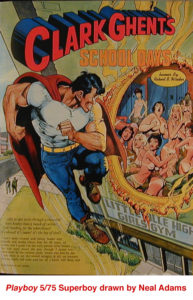 “Clark Ghent’s School Days” by Robert S. Wieder. Three pages of text and full page color illustration by Neal Adams.
“Clark Ghent’s School Days” by Robert S. Wieder. Three pages of text and full page color illustration by Neal Adams.
This parody of Superboy/Clark Kent may be of interest to Superman collectors but the reason I’ve included it is for the Neal Adams illustration. Many of Adams’s many fans are unaware of this piece. As children reading Superman comic books we all fantasized about what we would do if we really had Superman’s powers. Instead of fighting crime and other noble pursuits, I’m sure many of us would have elected to what Adams depicts here.
Oui Aug 1975
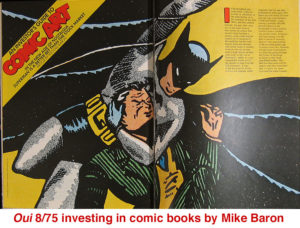 “Investor’s Guide To Comic Art” by Mike Baron. Six pages including a nearly two page 1940s illustration of Batman, a checklist of the 32 most valuable comic books and color reprints of two Golden Age comic book covers.
“Investor’s Guide To Comic Art” by Mike Baron. Six pages including a nearly two page 1940s illustration of Batman, a checklist of the 32 most valuable comic books and color reprints of two Golden Age comic book covers.
The is one of the most accurate and prescient articles on comic books to appear outside of comic related publications. Not surprising, since its author, Mike Baron was a future comic book writer.
The thrust of the article is that after years of obscurity and public scorn, comic book collecting was finally becoming respectable. I’m surprised at his harsh comments about collectors since the author is one himself, but I think his comments represented the public’s attitude then and still do partially today after years of imagined respectability. This quote from Baron is how he thinks the general public views comic books: “News dealers hate them. Comics are among the lowest profit items in the store, challenged only by candy bars for that honor; they occupy valuable display space better served by porn; and they attract undesirables who frequently drool over more expensive publications while deciding not what to buy. For decades, they remained he horror movies of the publishing industry.”
Baron’s survey of the comic collecting scene in 1975 includes: the Sub-Mariner in Motion Picture Funnies before Marvel Comics # 1, growing popularity of comic conventions, Stan Lee at Marvel Comics, the Overstreet Price Guide giving dealers an excuse to raise prices, 1900 pages of original art stolen from DC Comics’ offices, and the cult status of Frank Frazetta and Carl Barks.
One sign of a neglected hobby becoming respectable is speculator hoarding of new products. Baron relates Bruce Hamilton’s report on people in Phoenix, Arizona buying 100 copies of the first Joe Kubert DC Tarzan comic and also Shazam # 1 and trying to sell them for 1.60 on the secondary market. Also, distributors in New England running short of Wulf The Barbarian # 1 due to speculators hoarding thousands of copies.
These examples of idiot speculation aside, the article is optimistic about old comic book prices continuing to rise. As we know today, that optimism has been justified beyond anyone’s wildest imagination. Baron has this prophetic quote to his credit: “Pretty soon, all of the old comics will be in the hands of museums, or devout collectors, or screwballs with shotguns…”
Gallery March 1984
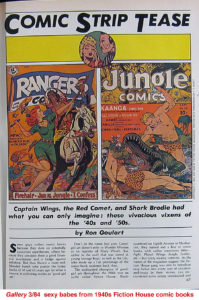 “Comic Strip Tease” by Ron Goulart. Three pages with color reprints of comic book covers and interiors mostly from Fiction House.
“Comic Strip Tease” by Ron Goulart. Three pages with color reprints of comic book covers and interiors mostly from Fiction House.
Long time writer and comic book historian Ron Goulart provides a concise overview of the “good girl art” appearing in comic books of the 1940s. Most of the article is devoted to that era’s leading comic publisher of that type of art, Fiction House. Goulart notes that almost every comic book cover in this publisher’s line had a sexy, scantily clad female on the cover. And the covers weren’t deceptive. Most of the stories featured similar females, always wearing the briefest amount of clothes the publishers thought they could get away with.
Goulart briefly notes some of the company’s cheesecake heroines – Senorita Rio, Glory Forbes, Firehair, Mysta of the Moon, Patsy Pinup, Sky Girl. He dwells a bit longer on Fiction House’s most famous creation, Sheena Queen of the Jungle, who had her own TV show in the 1950s starring Irish McCalla.
After finishing off Fiction House, Goulart quickly checks off some of the other best remembered female crime fighters and voluptuaries from other publishers: Phantom Lady with her penchant for being tied up and her art by Matt Baker; Miss Fury, drawn by female artist Tarpe Mills and published by Marvel Comics in only eight issues over five years; pinup artist Bill Ward’s creation, Torchy, who wasn’t a crime fighter but apparently a lingerie model instead.
Playboy December 1988
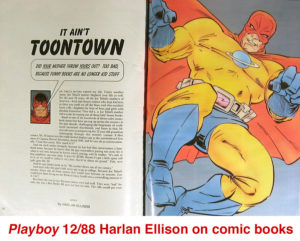 “It Ain’t Toontown” by Harlan Ellison. Ten pages including a full page color illustration of a generic superhero and six color reprints of comic book covers from independent publishers. If a writer has a substantial piece published in an important magazine like Playboy he is probably well known and maybe even famous. Maybe even as famous as, well, as famous as Harlan Ellison. Now if we just get a famous writer who is approved by the elitist literary establishment to write a big article about comic books in a really important magazine, like The New Yorker , there will be no more worlds to conquer.
“It Ain’t Toontown” by Harlan Ellison. Ten pages including a full page color illustration of a generic superhero and six color reprints of comic book covers from independent publishers. If a writer has a substantial piece published in an important magazine like Playboy he is probably well known and maybe even famous. Maybe even as famous as, well, as famous as Harlan Ellison. Now if we just get a famous writer who is approved by the elitist literary establishment to write a big article about comic books in a really important magazine, like The New Yorker , there will be no more worlds to conquer.
Ellison spends the first part of the article describing how comic books, after 50 years of neglect and ridicule, are becoming accepted as legitimate art by mainstream society. Mainstream, but not yet elite society. He notes that famous comic book artists are unknown to those “who stock…the Guggenheim [museum] and “Siegel and Shuster’s Superman does not hang in the Museum of Modern Art, and the imitations of Warhol and Lichtenstein do.”
Ellison’s main theme however is not defending comics as art or attacking their detractors, but in celebrating how creative and vital they have become after escaping the restrictive controls of the traditional comic book publishers. His attack on these old time publishers is almost vicious. He describes them as “plantation” masters who kept their workers slaving away in the “beanfields” or worse, the “Gulag.” I think Gulag may be a bit extreme. I don’t think Harry Donnenfeld or Martin Goodman ever had anybody shot.
To make his case Ellison offers a detailed story on how Jerry Siegel and Joe Shuster sold the rights to Superman in DC Comics in 1938 which set the pattern for the next 50 years. His anecdotal descriptions of their subsequent poverty compared to the vast wealth accumulated by DC from the Superman copyright is appropriately heart-rending. It reads like something out of a Charles Dickens novel.
He also relates the reduced circumstances suffered by legendary artists Wally Wood, Jack Kirby, Jack Cole and Reed Crandall, all allegedly from working to long in the comics business. Ellison even blames the plantation masters for the death of Atlas artist Joe Maneely, who died in a train accident.
Ellison goes on to describe the spread of the network of direct sales comic shops, the creation of new publishers and the refusal of top talents like Frank Miller to continue doing work-for-hire. All of this led to the partial dismantling of the Gulag and the resulting current renaissance in comic book art.
Lastly, he offers brief but positive reviews of the best new comics most of which are from independent publishers: The Watchmen, The Dark Knight Returns, The Fish Police, Omaha The Cat Dancer and others. You don’t have to agree or disagree with Mr. Ellison’s strongly worded opinions to enjoy this article. You may be invigorated or irritated, but you will almost certainly not be bored.

